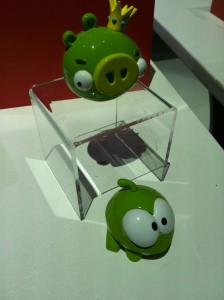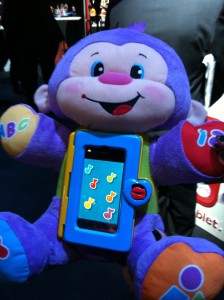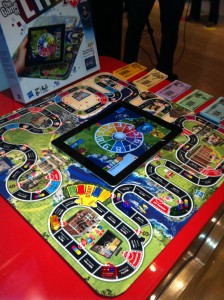This is the 6 BILLION dollar question this year. If toy makers have their way, the answer will be a resounding yes. In fact, it seems that many are betting the farm on it. With APP sales exceeding $6 billion in 2010 and estimated to reach $25 billion by 2015, you can’t really blame them for wanting a piece of this mega pie.
The big take away trend of TOY FAIR 2012, that officially begins tomorrow at the Javits Center in New York City, is the arrival of digital “enhancing” toys. There’s even a whole new vocabulary: you’ll hear that your child needs toys that help “blend” their reality and digital play experiences. Clever new brand lines such as Apptivity (Mattel) or AppGear (WowWee) or AppMates (Disney).
But at the end of the day, does your 18 month old baby really need a bear with an iPhone for a belly? Does your four year old who loves Hot Wheels really need to have a special car to race on the surface of your iPad? Does your child need a plastic fishing rod so that he or she can “virtually” fish with an attached smartphone?
I was pretty cranky this week as I started previewing this new category. I couldn’t quite put my finger on why and then yesterday, after having visited both Mattel and Hasbro’s showrooms, it became clearer to me. I wasn’t exactly cranky, just a little bit sad. I love toys. I’m always excited to see what those clever toy makers are going to wow us with. What innovative uses of technology would we be able to share with our readers? Unfortunately, this new category feels like the toy industry is desperately trying to remain relevant in a world where even the youngest children (who are not even talking yet), can navigate their parents smartphones and tablets.
The question for us always comes back to whether the technology enhances the play experience. In other words, do you need a toy to have the same or greater amount of pleasure when playing Fruit Ninjas or Angry Birds? Is the APP experience lacking or less than optimal if you don’t have these 3D action figures? Does having an iPhone APP at the center of your game board really make playing a round of LIFE or Monopoly better? As with most new categories we review, the ultimate answer will be made on a case by case basis.
In the swirl of wow-look-what-we-can-do-now in toyland, it’s almost easy to miss the next important question. Is this toy developmentally appropriate? We know that handing off iPhones and iPads to very young children has become part of our culture. Parents often marvel at how well their kids navigate such experiences, and we all know that such a hand off can be particularly useful when you travel or on a tedious line at the grocery store. (I can barely make it through the Whole Foods line without my phone.) But now ask yourself whether it’s beneficial to extend that time by adding toys to the experience. What other real world play experiences are being missed by adding more screen time? While the technology is far too new for studies that research the impact on small children, at this point we see no reason why this screen time will be vastly different from television, baby videos, or video games and their negative impact on children. In other words, less will probably be more. And when you’re talking about very young children, none may be even better. Not a popular suggestion we know. As with most things, we have a sense that moderation is probably the most realistic goal.
One more thing. It also seems somewhat tone deaf to be suggesting in these difficult financial times that expensive technology must be acquired for playtime. I know we all have phones and according to the folks at Mattel, one in every five house holds owns an iPad – but still. From a consumer point of view, board games have always offered great value. Most games cost under $20. Now, that’s $20 plus the cost of your iPad or iPhone.
I feel much better now. And while I understand that toy companies want in on this booming business, I hope that all of those creative toy makers will remember that playing in the real world with wonderfully crafted playthings is still something to be valued.




Thank you for a great post with lots to think about! I think you’re right that moderation is the key, and we as parents have to put our foot down. We can’t avoid the technology, but we can try to let our children have more creative and unstructured play for as long as possible.
Great post. I agree, Eva. Putting our foot down – and – having a conversation about what it means and feels like to be “connected” to the world without the use of technology. Walking in the woods, feeling bark, flower petals, listening to whispers or shouts, etc…
I love this post. As a mom of toddler twins, I see a lot of my twin mom friends buying toys (x2!) that are: 1) Expensive; 2) Overstimulating. My twins and I recently discovered the pure joy in going outside, picking up sticks and rocks, and making a mud castles with these items in our backyard. They had a better time playing outside than they have ever had playing with one of their noisy, technology-rich toys.
In my opinion, many toys these days squash a kids’ natural ability to be creative because it does the work for them.
As an aside, my kids get a hold of my iphone, and they have no clue what to do with it other than take their toy wooden hammer and bang it on the iphone screen…
Toys with Apps I feel will be over stimulation for any child. The tablet, iPhone, ect., stimulates the child enough without adding more. Children need to be children, hands on, creating, anything that encourages development and growth without over stimulation. The technology offered today, in moderation, can add development and growth, but overload in my opinion isn’t beneficial to any child.
Abbe